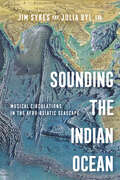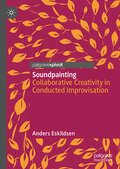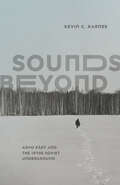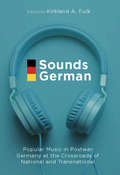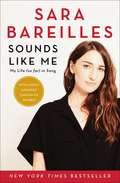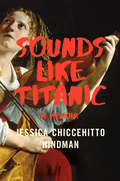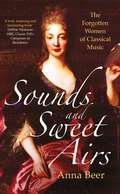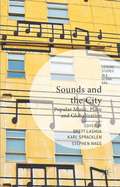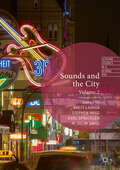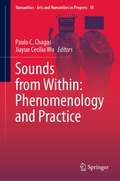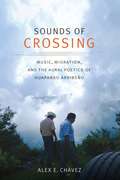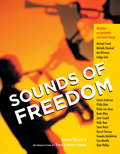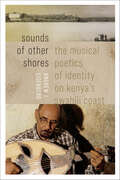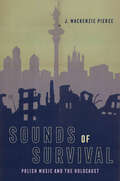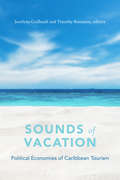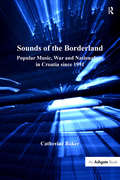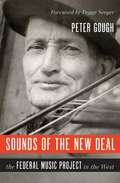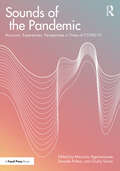- Table View
- List View
Sounding the Indian Ocean: Musical Circulations in the Afro-Asiatic Seascape
by Prof. Jim Sykes Prof. Julia Suzanne BylA free ebook version of this title is available through Luminos, University of California Press’s Open Access publishing program. Visit www.luminosoa.org to learn more.Sounding the Indian Ocean is the first volume to integrate the fields of ethnomusicology and Indian Ocean studies. Drawing on historical and ethnographic approaches, the book explores what music reveals about mobility, diaspora, colonialism, religious networks, media, and performance. Collectively, the chapters examine different ways the Indian Ocean might be "heard" outside of a reliance on colonial archives and elite textual traditions, integrating methods from music and sound studies into the history and anthropology of the region. Challenging the area studies paradigm—which has long cast Africa, the Middle East, and Asia as separate musical cultures—the book shows how music both forms and crosses boundaries in the Indian Ocean world.
Sounding the Virtual: Gilles Deleuze And The Theory And Philosophy Of Music
by Nick NesbittIt is the contention of the editors and contributors of this volume that the work carried out by Gilles Deleuze, where rigorously applied, has the potential to cut through much of the intellectual sedimentation that has settled in the fields of music studies. Deleuze is a vigorous critic of the Western intellectual tradition, calling for a 'philosophy of difference', and, despite its ambitions, he is convinced that Western philosophy fails to truly grasp (or think) difference as such. It is argued that longstanding methods of conceptualizing music are vulnerable to Deleuze's critique. But, as Deleuze himself stresses, more important than merely critiquing established paradigms is developing ways to overcome them, and by using Deleuze's own concepts this collection aims to explore that possibility.
Soundpainting: Collaborative Creativity in Conducted Improvisation (Palgrave Studies in Sound)
by Anders EskildsenThis book explores Soundpainting, a multidisciplinary sign language for live composition and conducted improvisation, highlighting its role in facilitating creative, social interactions in music and other performative arts. Examining the meaning of Soundpainting’s syntax, the connection between constraints and creativity in hand signs, and the means for dynamic distribution and transformation of agency within ensembles, the book provides insight into the nature of cocreation and the organization of creative processes.
Sounds Beyond: Arvo Pärt and the 1970s Soviet Underground
by Kevin C. KarnesSounds Beyond charts the origins of Arvo Pärt’s most famous music, which was created in dialogue with underground creative circles in the USSR. In Sounds Beyond, Kevin C. Karnes studies the interconnected alternative music and art scenes in the USSR during the second half of the 1970s, revealing the audacious origins of some of Estonian composer Arvo Pärt’s most famous music. Karnes shows how Pärt’s work was created within a vital yet forgotten culture of collective experimentation, the Soviet underground. Mining archives and oral history from across the former USSR, Sounds Beyond carefully situates modes of creative experimentation within their late socialist contexts. In documenting Pärt’s work, Karnes reveals the rich creative culture that thrived covertly in the USSR and the network of figures that made underground performances possible: students, audio engineers, sympathetic administrators, star performers, and aspiring DJs. Sounds Beyond advances a new understanding of Pärt’s music as an expression of the aesthetic and religious commitments shared, nurtured, and celebrated by many in Soviet underground circles. At the same time, this story attests to the lasting power of Pärt’s music. Dislodging the mythology of the solitary creative genius, Karnes shows that Pärt’s work would be impossible without community.
Sounds German: Popular Music in Postwar Germany at the Crossroads of the National and Transnational
by Kirkland A. FulkFor decades, Germany has been shaped and reshaped by the sounds of popular music—whether viewed as uniquely German or an ideological invader from abroad. This collected volume brings together leading figures in the field of German Studies, popular music studies, and cultural studies at large to survey the sociopolitical impact of music on conceptions of the German state and national identity, gender and sexuality, and transnational cultural production and consumption, expanding on the ways in which sounds, technologies, media practices, and exchanges of popular music provide a unique glimpse into the cultural dynamics of postwar Germany.
Sounds Like Helicopters: Classical Music in Modernist Cinema (SUNY series, Horizons of Cinema)
by Matthew LauExplores how modernist films use classical music in ways that restore the music's original subversive energy.Classical music masterworks have long played a key supporting role in the movies-silent films were often accompanied by a pianist or even a full orchestra playing classical or theatrical repertory music-yet the complexity of this role has thus far been underappreciated. Sounds Like Helicopters corrects this oversight through close interpretations of classical music works in key modernist films by Francis Ford Coppola, Werner Herzog, Luis Buñuel, Stanley Kubrick, Jean-Luc Godard, Michael Haneke, and Terrence Malick. Beginning with the famous example of Wagner's "Ride of the Valkyries" in Apocalypse Now, Matthew Lau demonstrates that there is a significant continuity between classical music and modernist cinema that belies their seemingly ironic juxtaposition. Though often regarded as a stuffy, conservative art form, classical music has a venerable avant-garde tradition, and key films by important directors show that modernist cinema restores the original subversive energy of these classical masterworks. These films, Lau argues, remind us of what this music sounded like when it was still new and difficult; they remind us that great music remains new music. The pattern of reliance on classical music by modernist directors suggests it is not enough to watch modernist cinema: one must listen to its music to sense its prehistory, its history, and its obscure, prophetic future.
Sounds Like Me: My Life (So Far) in Song
by Sara BareillesAn anniversary edition of The New York Times bestselling collection of essays by two-time Grammy Award winner, creator of Little Voice on Apple TV+, and star of Netflix&’s Girls5eva Sara Bareilles &“resonates with authentic and hard-won truths&” (Publishers Weekly)—and features new material on the hit Broadway musical Waitress.Sara Bareilles &“pours her heart and soul into these essays&” (Associated Press), sharing the joys and the struggles that come with creating great work, all while staying true to yourself. Imbued with humor and marked by Sara&’s confessional writing style, this essay collection tells the inside story behind some of her most popular songs. Well known for her chart-topper &“Brave,&” Sara first broke through in 2007 with her multi-platinum single &“Love Song.&” She has since released seven studio albums that have sold millions of copies and spawned several hits, not to mention creating and starring in the hit Broadway musical Waitress. &“A breezy, upbeat, and honest reflection of this multitalented artist&” (Kirkus Reviews), Sounds Like Me reveals Sara Bareilles, the artist—and the woman—on songwriting, soul-searching, and what&’s discovered along the way.
Sounds Like Titanic: A Memoir
by Jessica Chiccehitto HindmanA young woman leaves Appalachia for life as a classical musician—or so she thinks. When aspiring violinist Jessica Chiccehitto Hindman lands a job with a professional ensemble in New York City, she imagines she has achieved her lifelong dream. But the ensemble proves to be a sham. When the group “performs,” the microphones are never on. Instead, the music blares from a CD. The mastermind behind this scheme is a peculiar and mysterious figure known as The Composer, who is gaslighting his audiences with music that sounds suspiciously like the Titanic movie soundtrack. On tour with his chaotic ensemble, Hindman spirals into crises of identity and disillusionment as she “plays” for audiences genuinely moved by the performance, unable to differentiate real from fake. Sounds Like Titanic is a surreal, often hilarious coming-of-age story. Hindman writes with precise, candid prose and sharp insight into ambition and gender, especially when it comes to the difficulties young women face in a world that views them as silly, shallow, and stupid. As the story swells to a crescendo, it gives voice to the anxieties and illusions of a generation of women, and reveals the failed promises of a nation that takes comfort in false realities.
Sounds and Sweet Airs: The Forgotten Women of Classical Music
by Anna BeerFrancesca Caccini. Barbara Strozzi. Élisabeth Jacquet de la Guerre. Marianna Martines. Fanny Hensel. Clara Schumann. Lili Boulanger. Elizabeth Maconchy.Great composers all, but their musical legacy is still rarely acknowledged.Since the birth of classical music, those women who dared to compose have been patronised, had their sex lives scrutinised and the veracity of their authorship questioned. They worked within a musical culture where beliefs about what women could and could not do determined their every move. Yet, time and again there emerged individuals who would evade, confront and ignore the rules that sought to exclude them from the world of composition.Taking the reader on a journey from seventeenth-century Medici Florence to London in the Blitz, and beyond, Anna Beer reveals the hidden histories of eight remarkable women, explores the special communities that enabled them to compose their music, and asks tough questions about why we still don't hear their masterpieces performed.A long-overdue celebration of neglected virtuosos, Sounds and Sweet Airs presents a complex and inspirational picture of artistic endeavour and achievement that deserves to be part of our cultural heritage.
Sounds and the City
by Stephen Wagg Karl Spracklen Brett LashuaThis book explores the ways in which Western-derived music connects with globalization, hybridity, consumerism and the flow of cultures. Both as local terrain and as global crossroads, cities remain fascinating spaces of cultural contestation and meaning-making via the composing, playing, recording and consumption of popular music.
Sounds and the City: Volume 2 (Leisure Studies in a Global Era)
by Stephen Wagg Karl Spracklen Brett Lashua M. Selim YavuzThis book draws from a rich history of scholarship about the relations between music and cities, and the global flows between music and urban experience. The contributions in this collection comment on the global city as a nexus of moving people, changing places, and shifting social relations, asking what popular music can tell us about cities, and vice versa. Since the publication of the first Sounds and the City volume, various movements, changes and shifts have amplified debates about globalization. From the waves of people migrating to Europe from the Syrian civil war and other conflict zones, to the 2016 “Brexit” vote to leave the European Union and American presidential election of Donald Trump. These, and other events, appear to have exposed an anti-globalist retreat toward isolationism and a backlash against multiculturalism that has been termed “post-globalization.” Amidst this, what of popular music? Does music offer renewed spaces and avenues for public protest, for collective action and resistance? What can the diverse histories, hybridities, and legacies of popular music tell us about the ever-changing relations of people and cities?
Sounds from Within: Phenomenology and Practice (Numanities - Arts and Humanities in Progress #18)
by Paulo C. Chagas Jiayue Cecilia WuThis book transforms phenomenology, music, technology, and the cultural arts from within. Gathering contributions by performing artists, media technology designers, nomadic composers, and distinguished musicological scholars, it explores a rich array of concepts such as embodiment, art and technology, mindfulness meditation, time and space in music, self and emptiness, as well as cultural heritage preservation. It does so via close studies on music phenomenology theory, works involving experimental music and technology, and related cultural and historical issues. This book will be of considerable interest to readers from the fields of sound studies, science and technology studies, phenomenology, cultural studies, media studies, and sound art theory. This book is equally relevant and insightful for musicians, composers, media artists, sound artists, technology designers, and curators and arts administrators from the performing and visual arts.
Sounds from the Other Side: Afro–South Asian Collaborations in Black Popular Music
by Elliott H. PowellA sixty-year history of Afro–South Asian musical collaborations From Beyoncé&’s South Asian music–inspired Super Bowl Halftime performance, to jazz artists like John and Alice Coltrane&’s use of Indian song structures and spirituality in their work, to Jay-Z and Missy Elliott&’s high-profile collaborations with diasporic South Asian artists such as the Panjabi MC and MIA, African American musicians have frequently engaged South Asian cultural productions in the development of Black music culture. Sounds from the Other Side traces such engagements through an interdisciplinary analysis of the political implications of African American musicians&’ South Asian influence since the 1960s. Elliott H. Powell asks, what happens when we consider Black musicians&’ South Asian sonic explorations as distinct from those of their white counterparts? He looks to Black musical genres of jazz, funk, and hip hop and examines the work of Miles Davis, John Coltrane, Rick James, OutKast, Timbaland, Beyoncé, and others, showing how Afro–South Asian music in the United States is a dynamic, complex, and contradictory cultural site where comparative racialization, transformative gender and queer politics, and coalition politics intertwine. Powell situates this cultural history within larger global and domestic sociohistorical junctures that link African American and South Asian diasporic communities in the United States. The long historical arc of Afro–South Asian music in Sounds from the Other Side interprets such music-making activities as highly political endeavors, offering an essential conversation about cross-cultural musical exchanges between racially marginalized musicians.
Sounds of Crossing: Music, Migration, and the Aural Poetics of Huapango Arribeño
by Alex E. ChávezIn Sounds of Crossing Alex E. Chávez explores the contemporary politics of Mexican migrant cultural expression manifest in the sounds and poetics of huapango arribeño, a musical genre originating from north-central Mexico. Following the resonance of huapango's improvisational performance within the lives of audiences, musicians, and himself—from New Year's festivities in the highlands of Guanajuato, Mexico, to backyard get-togethers along the back roads of central Texas—Chávez shows how Mexicans living on both sides of the border use expressive culture to construct meaningful communities amid the United States’ often vitriolic immigration politics. Through Chávez's writing, we gain an intimate look at the experience of migration and how huapango carries the voices of those in Mexico, those undertaking the dangerous trek across the border, and those living in the United States. Illuminating how huapango arribeño’s performance refigures the sociopolitical and economic terms of migration through aesthetic means, Chávez adds fresh and compelling insights into the ways transnational music-making is at the center of everyday Mexican migrant life.
Sounds of Freedom
by Thich Nhat Hanh John MalkinIn Sounds of Freedom, sixteen extraordinary musicians share their intimate thoughts on art, spirituality, and social change. These intimate interviews offer a rare glimpse into the personal motivations of these public artists.Includes interviews with: Michael Franti, Michelle Shocked, Ani DiFranco, Indigo Girls, Laurie Anderson, Philip Glass, Rickie Lee Jones, Boots Riley, John Trudell, Holly Near, Steve Reich, Darryl Cherney, Goapele Mohlabane, Tom Morello, Utah Philips.
Sounds of Freedom: Musicians on Spirituality and Social Change
by John MalkinSounds of Freedom brings together some of the contruy's best-known musicians to share their thoughts on spirituality and social change. Philip Glass, the Indigo girls, Michael Franti, Michelle Shocked, Laurie Anderson and others reveal their inspiration and their commitments to peace and justice. Featuring a foreword by Vietnamese Zen Master Thcih Nhat Hanh and a bonus CD of songs by the artists in the book, offers rare insight into the hearts of these musicians.
Sounds of Other Shores: The Musical Poetics of Identity on Kenya's Swahili Coast
by Andrew J. EisenbergSounds of Other Shores takes an ethnographic ear to the history of transoceanic stylistic appropriation in the Swahili taarab music of the Kenyan coast. Swahili taarab, a form of sung poetry that emerged as East Africa's first mass-mediated popular music in the 1930s, is a famously cosmopolitan form, rich in audible influences from across the Indian Ocean. But the variants of the genre that emerged in the Kenyan coastal city of Mombasa during the twentieth century feature particularly dramatic, even flamboyant, appropriations of Indian and Arab sonic gestures and styles. Combining oral history, interpretive ethnography, and musical analysis, Sounds of Other Shores explores how Swahili-speaking Muslims in twentieth-century Mombasa derived pleasure and meaning from acts of transoceanic musical appropriation, arguing that these acts served as ways of reflecting on and mediating the complexities and contradictions associated with being "Swahili" in colonial and postcolonial Kenya. The result is a musical anthropology of Kenyan Swahili subjectivity that reframes longstanding questions about Swahili identity while contributing to broader discussions about identity and citizenship in Africa and the Indian Ocean world.
Sounds of Survival: Polish Music and the Holocaust
by J. Mackenzie PierceSounds of Survival tells a story of unexpected musical continuity across some of the twentieth century's most cataclysmic events. It examines an integrated Polish and Polish Jewish musical community as its members contended with antisemitism in the 1930s, attempted to survive the Nazi occupation, and established a renewed musical culture amid the ashes of World War II and the Holocaust. Reconstructing these musicians' lives from the 1920s into the 1950s, J. Mackenzie Pierce argues that despite nearly unimaginable violence, many Polish musicians treated the war as a time of reinvention and cultural preservation. Their faith that music was a source of cultural continuity, however, also marginalized experiences of wartime loss, especially those of Jewish victims and survivors of the Holocaust. Sounds of Survival not only reveals that the Holocaust was a central event within modern Polish musical culture; it also shows why its musical aftermath has been difficult to hear.
Sounds of Vacation: Political Economies of Caribbean Tourism
by Timothy Rommen Jocelyne GuilbaultThe contributors to Sounds of Vacation examine the commodification of music and sound at popular vacation destinations throughout the Caribbean in order to tease out the relationships between political economy, hospitality, and the legacies of slavery and colonialism. Drawing on case studies from Barbados, the Bahamas, Guadeloupe, Saint Martin, and Saint Lucia, the contributors point to the myriad ways live performances, programmed music, and the sonic environment heighten tourists' pleasurable vacation experience. They explore, among other topics, issues of authenticity in Bahamian music; efforts to give tourists in Barbados peace and quiet at a former site of colonial violence; and how resort soundscapes extend beyond music to encompass the speech accents of local residents. Through interviews with resort managers, musicians, and hospitality workers, the contributors also outline the social, political, and economic pressures and interests that affect musical labor and the social encounters of musical production. In so doing, they prompt a rethinking of how to account for music and sound's resonances in postcolonial spaces. Contributors. Jerome Camal, Steven Feld, Francio Guadeloupe, Jocelyne Guilbault, Jordi Halfman, Susan Harewood, Percy C. Hintzen, Timothy Rommen
Sounds of the Borderland: Popular Music, War and Nationalism in Croatia since 1991 (Ashgate Popular and Folk Music Series)
by Catherine BakerSounds of the Borderland is the first book-length study of how popular music became a medium for political communication and contested identification during and after Croatia's war of independence from Yugoslavia. It extends existing cultural studies literature on music, politics and the state, which has largely been grounded in Western European and North American political systems. It also responds to an emerging fascination with the culture and politics of contemporary south-east Europe, expanding scholarship on the post-Yugoslav conflicts by going on to encompass significant social and political changes into the present day. The outbreak of war in 1991 saw almost every professional musician in Croatia take part in a wave of patriotic music-making and the powerful state television system strive to bring popular music under its control. As the political imperative shifted from securing national survival to consolidating a homogenous nation-state, the music industry responded with several strategies for creating a national popular music, producing messages about the nation and, in the ongoing debates over the origins of the folk music that inspired many songs, a way to define the nation by expressing what Croatia was not. The war on ethnic ambiguity which cut through individuals' social and creative lives played out across the airwaves, sales racks and gossip columns of a small country that imagined itself a historical and cultural borderland. These explicit and implicit narratives of nationhood connect many political phases: the months of fiercest fighting, the stabilised front, the uneasy post-war years when the symbolic frontline region of eastern Slavonia had still not returned to Croatian sovereignty, the euphoria and instability after the end of the Tudjman regime in 2000, and Croatia's fraught journey towards the European Union. Baker's book provides valuable insight into the role of music in a wartime and post-conflict society and will be essential reading for researchers and students interested in south-east Europe or the transformation of entertainment during and after conflict.
Sounds of the Citizens: Dancehall and Community in Jamaica
by Anne GalvinDancehall: It's simultaneously a source of raucous energy in the streets of Kingston, Jamaica; a way of life for a group of professional artists and music professionals; and a force of stability and tension within the community. Electronically influenced, relevant to urban Jamaicans, and highly danceable, dancehall music and culture forms a core of popular entertainment in the nation. As Anne Galvin reveals in Sounds of the Citizens, the rhythms of dancehall music reverberate in complicated ways throughout the lives of countless Jamaicans. Galvin highlights the unique alliance between the dancehall industry and community development efforts. As the central role of the state in supporting communities has diminished, the rise of private efforts such as dancehall becomes all the more crucial. The tension, however, between those involved in the industry and those within the neighborhoods is palpable and often dangerous. Amidst all this, individual Jamaicans interact with the dancehall industry and its culture to find their own paths of employment, social identity, and sexual mores. As Sounds of the Citizens illustrates, the world of entertainment in Jamaica is serious business and uniquely positioned as a powerful force within the community.
Sounds of the Citizens: Dancehall and Community in Jamaica
by Anne M. GalvinDancehall: it's simultaneously a source of raucous energy in the streets of Kingston, Jamaica; a way of life for a group of professional artists and music professionals; and a force of stability and tension within the community. Electronically influenced, relevant to urban Jamaicans, and highly danceable, dancehall music and culture forms a core of popular entertainment in the nation. As Anne Galvin reveals in Sounds of the Citizens, the rhythms of dancehall music reverberate in complicated ways throughout the lives of countless Jamaicans. Galvin highlights the unique alliance between the dancehall industry and community development efforts. As the central role of the state in supporting communities has diminished, the rise of private efforts such as dancehall becomes all the more crucial. The tension, however, between those involved in the industry and those within the neighborhoods is palpable and often dangerous. Amidst all this, individual Jamaicans interact with the dancehall industry and its culture to find their own paths of employment, social identity, and sexual mores. As Sounds of the Citizens illustrates, the world of entertainment in Jamaica is serious business and uniquely positioned as a powerful force within the community.
Sounds of the New Deal: The Federal Music Project in the West (Music in American Life)
by Peter Gough Peggy SeegerAt its peak the Federal Music Project (FMP) employed nearly 16,000 people who reached millions of Americans through performances, composing, teaching, and folksong collection and transcription. In Sounds of the New Deal, Peter Gough explores how the FMP's activities in the West shaped a new national appreciation for the diversity of American musical expression. From the onset, administrators and artists debated whether to represent highbrow, popular, or folk music in FMP activities. Though the administration privileged using "good" music to educate the public, in the West local preferences regularly trumped national priorities and allowed diverse vernacular musics to be heard. African American and Hispanic music found unprecedented popularity while the cultural mosaic illuminated by American folksong exemplified the spirit of the Popular Front movement. These new musical expressions combined the radical sensibilities of an invigorated Left with nationalistic impulses. At the same time, they blended traditional patriotic themes with an awareness of the country's varied ethnic musical heritage and vast--but endangered--store of grassroots music.
Sounds of the Pandemic: Accounts, Experiences, Perspectives in Times of COVID-19
by Maurizio Agamennone Daniele Palma Giulia SarnoSounds of the Pandemic offers one of the first critical analyses of the changes in sonic environments, artistic practice, and listening behaviour caused by the Coronavirus outbreak. This multifaceted collection provides a detailed picture of a wide array of phenomena related to sound and music, including soundscapes, music production, music performance, and mediatisation processes in the context of COVID-19. It represents a first step to understanding how the pandemic and its by-products affected sound domains in terms of experiences and practices, representations, collective imaginaries, and socio-political manipulations. This book is essential reading for students, researchers, and practitioners working in the realms of music production and performance, musicology and ethnomusicology, sound studies, and media and cultural studies.
Sounds of the South
by Daniel W. PattersonBeyond the familiar forms of Mississippi Delta Blues and mainstream country music, the vernacular music of the South also ranges from the ceremonial music of Native Americans, to "shout" singing in South Carolina sea islands, Cajun fiddling, and Mexican-American conjunto music. Sounds of the South assesses past efforts to document these richly varied musical forms and the challenges facing future work."Sounds of the South"--a 1989 conference that gathered record collectors, folklorists, musicians, record producers, librarians, archivists, and traditional music lovers--celebrated the official opening of the Southern Folklife Collection with the John Edwards Memorial Collection at the library of the University of North Carolina, Chapel Hill. Based on that conference, Sounds of the South includes Bill Malone's account of his own career as fan and scholar of country music, Paul Oliver on European blues scholarship, and Ray Funk on researching Black Gospel Quartets.The contributors look at a number of topics related to the role of the archivist/folklorist in recording and documenting the music of the South--evaluating past fieldwork and current needs in documentation, archival issues, prospects for the publication of recordings, and changes in music and technology. Written in an accessible style, this volume will be of interest to all those concerned with preserving the music of the American South.
